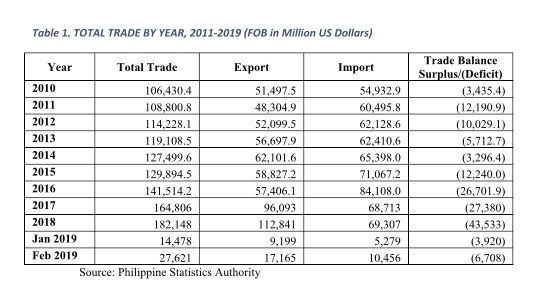International trade and Philippine economic growth

No one country has all the necessary resources or capacity to satisfy the need of their own people. However, by developing and exploiting their domestic resources, one country can produce a surplus, and trade them for the surplus products of other countries that they need.
In this modern world, international trade is at the heart of the global economy and is responsible for much of the development and prosperity of the many nations. First with the western countries beginning with England where the industrial revolution started, followed by Japan that became the first none-western country to join the developed world of the west, and later by South Korea, and other newly industrializing countries, including China.
International trade though has also its own disadvantages. It can lead to over-specialization, for example, with workers losing their jobs when world demand for their product falls or when goods for domestic consumption can be produced more cheaply abroad. Jobs lost through such changes can cause a lot of trouble to many people and certain countries.
International trade can also be bad for the global economy when one country pursue a policy of mercantilism that requires more exporting than importing at the expense of other countries, like what the US thought of what China is doing with respect to their trade relations.
Mercantilism was in its heyday when precious metals, such as gold and silver, were deemed indispensable to a nation’s wealth and military power. If a nation did not possess mines or have access to them, trade would be used to obtain those precious metals. Doing this requires a “favorable” balance of trade or an excess of exports over imports to the detriment of other countries that later on forces them to retaliate by reducing their own imports. When this happens, many countries will suffer from diminished trade.
Advocates of laissez-faire criticize mercantilism by arguing that there was really no difference between domestic and foreign trade and trade was beneficial to all trading partners. Today most countries in the world are participating in international trade, including the Philippines under the aegis of the World Trade Organization.
With international trade, the economy is in balance when aggregate demand, consisting of final household consumption expenditures, final government consumption expenditures, investments (both public and private), and net exports (export minus imports) just matches aggregate production or supply coming from all the productive sectors of the economy.
It can be shown that when a country’s net export is positive, its gross domestic product or total output of goods and services is higher than when net export is negative. Hence, many countries would endeavor to export more than their imports like what Japan successfully did after the last war up to the 1980s and China from the 1980s up to now.
Both did it mostly at the expense of the US, if we were to believe the American narrative. Hence, their antagonism to the Japanese in the 1980s and now to the Chinese that it currently pressures to open up their market to more US exports.
What is our own trade experience in the Philippines?
Well, it is unfortunate that in most years in the past, not only that our total trade is one of the smallest in Asia as a fraction of the GDP, we also had always been importing more than exporting in the past.
This could be one reason why our GDP was one of the slowest to grow in the last fifty years of the previous century, which put us behind our neighbors in terms of material welfare by the time we enter the new millennium.
Led by consumption, we grew a little faster at around 4.8 percent annually in the first decade of the new century, and faster still at 6.2 percent annually in the next six years through more investments, which growth has even accelerated in the last two years through more government expenditures.
We could have done more if we also endeavored to reduce, if not reverse, our trade deficit that cuts into our GDP growth. The table below shows that since 2016 our trade deficit had been growing by the twenties of million US dollars annually from the tens of millions or less in the previous years. This is not a good sign because it means that much of our efforts to increase aggregate demand to push our GDP higher are only greatly diffused by our large and growing trade deficits.
Disclaimer: The comments uploaded on this site do not necessarily represent or reflect the views of management and owner of Cebudailynews. We reserve the right to exclude comments that we deem to be inconsistent with our editorial standards.

